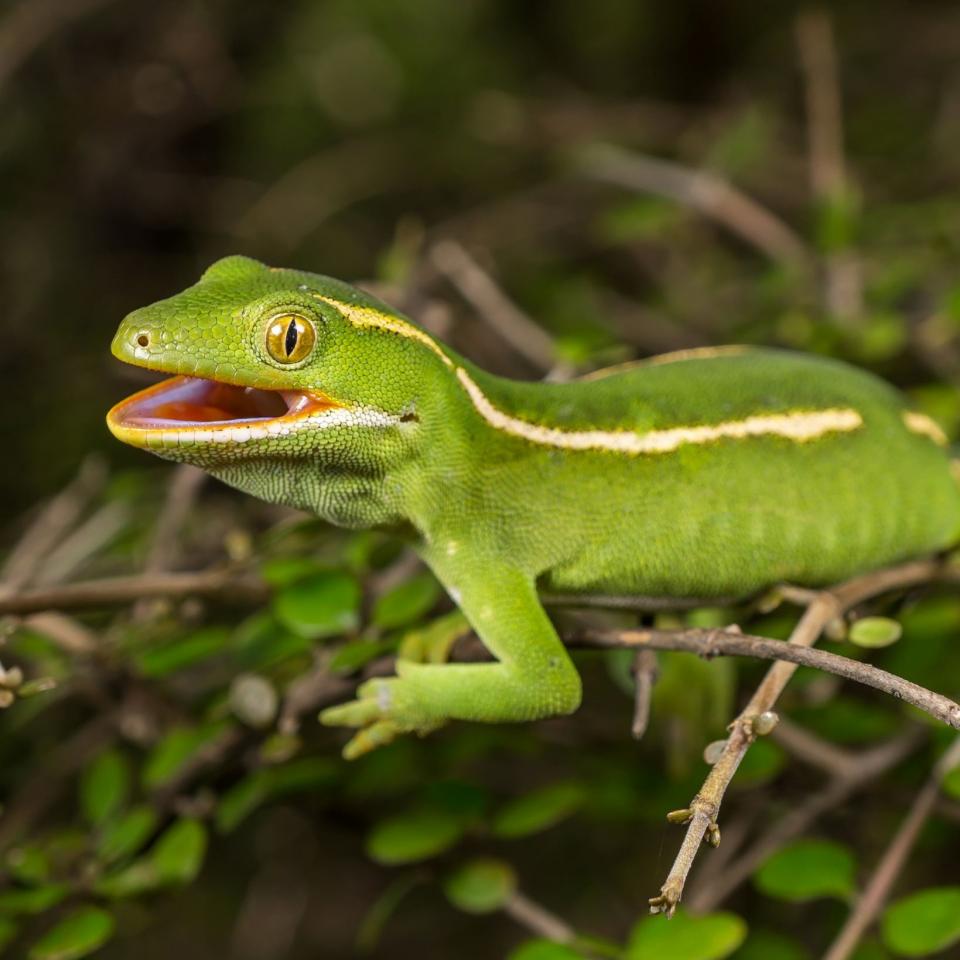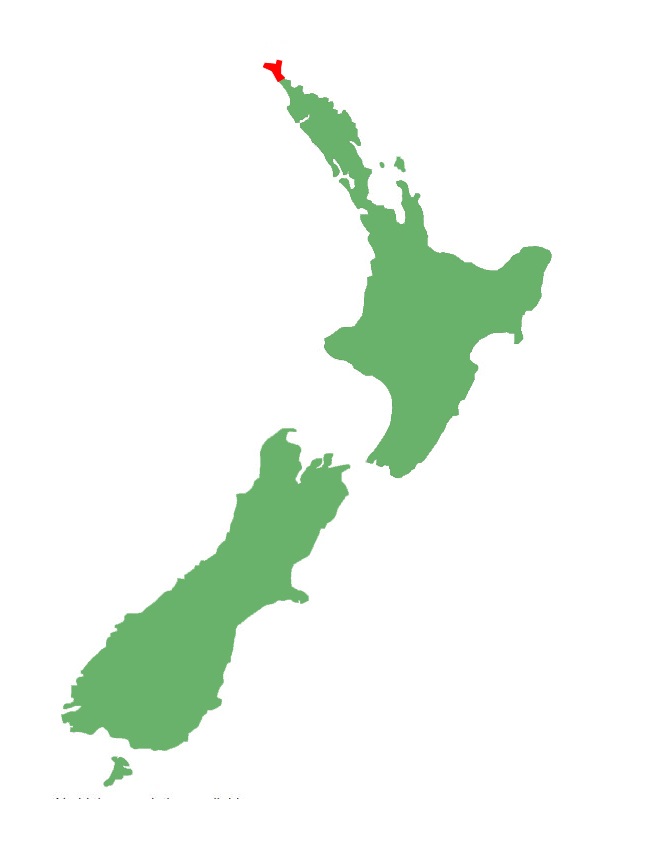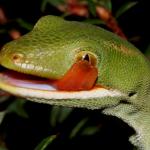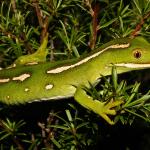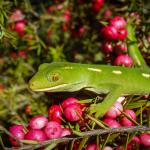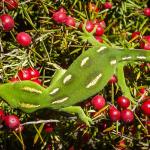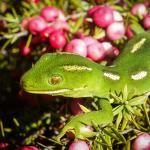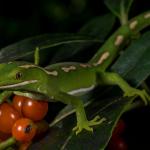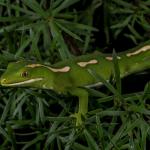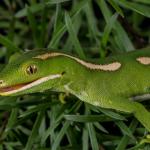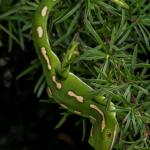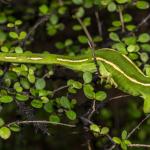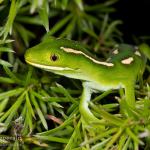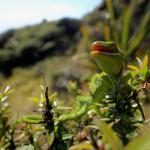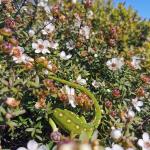- Home
- Herpetofauna Index
- Native
- Naultinus Flavirictus
Naultinus flavirictus
Aupōuri gecko | Kawariki
Naultinus flavirictus
(Hitchmough et al., 2021)
Length: SVL up to 84mm, with the tail being longer than the body length
Weight: up to 14 grams
Description
A small and beautiful emerald green gecko species found inhabiting the forested regions of the far northern tip of Aotearoa/New Zealand. Although long considered a unique species in their own right (distinct from the Northland green gecko (Naultinus grayii)), they were until recently (2021) undescribed to science.
In general, they are characterised by their bright green upper surfaces, which in some individuals are broken up by white or cream markings (either striped, blotched, or a combination of both) with thin yellow, dark green, or black outlines. The sides of the animals are much the same as the upper surfaces, although may be underlined by a thin white stripe. Their mouth is often bordered below by a white stripe which terminates at the opening of the ear, whilst both the upper and lower lips may be tinged with yellow/orange (giving rise to its previous common name 'the yellow-lipped gecko). As with most of our green gecko species, the Aupōuri gecko's ventral colour differs between males and females, with females having a green stomach, while males have a blue-tinged stomach.
Mouth and tongue colour is a key feature in distinguishing between North Island Naultinus species, and the Aupōuri gecko fits this pattern, having the unique combination of a pink/lilac mouth with a red tongue.
Aupōuri geckos at the southern extent of their distribution appear to be larger, and have more grayii-esque markings, potentially suggesting hybridisation in the past (N & T. Harker pers. comm 2021).
Xanthochromic (yellow) individuals have been reported.
Can be differentiated from other North Island green gecko species based on mouth colour, having a pink/lilac mouth with a red tongue vs. a blue mouth with a red tongue (N. grayii) or blue mouth with a black tongue (N. elegans, and N. punctatus). The canthal scales on the snout (domed vs. flat), and the maximum SVL (≤80mm vs. ≤100mm) are also useful in distinguishing it from the neighbouring Northland green gecko (N. grayii).
Life expectancy
Largely unknown, although they are likely to be long-lived like many of our other Naultinus species.
Captive green geckos have frequently been known to live for upwards of 25 years, with some individuals topping the records at 50+ (D. Keal pers. comm 2016). In the wild, green geckos have been recorded as reaching a minimum of ~15 years, although it is likely to be more than this given that the population in question was only monitored from 2009, and those animals are still alive (C. Knox pers. comm 2021).
Distribution
Restricted to the Aupōuri Peninsula at the northern tip of the North Island. Their true southern extent is uncertain, but is suspected to be somewhere around the northern Houhora harbour.
They are currently not known to occur on any islands within their range, however, they may have historically occurred on Motuopao off the tip of Cape Maria van Diemen.
Ecology and habitat
The Aupōuri gecko appears to be cathemeral (active both day and night) in nature, although predominantly considered diurnal (day-active), due to its strongly heliothermic nature (being an avid sun basker). As with all members of the Naultinus genus they are primarily arboreal (tree-dwelling), although can at times be found quite low to the ground in prostrate (ground hugging) vegetation. Although seldom seen on the ground, males can be found travelling between trees in search of mates during the breeding season. As with all green geckos, they possess a strongly prehensile tail which acts as a third-limb/climbing aid when moving through shrubs and trees. They are known to mouth gape and produce a barking sound as a defensive behaviour against potential predators.
Being an arboreal species, Aupōuri geckos are closely associated with forested habitats, and thus inhabit a wide variety of forest types on the Aupōuri Peninsula, including swamps, scrubland, and mature forest. They appear to favour scrubby/regenerating habitats, but this may be a result of the relative ease of access to, and amount of search effort that these sites garner.
Social structure
The Aupōuri gecko is solitary in nature, although can be found at fairly large densities in some habitats. Males show aggressive behaviour toward congeners, especially during the breeding season, and this is easily observable with many males showcasing scarring over their bodies. Mate guarding seems to occur in this species, with males often found in close proximity to females prior to birthing. Although independent at birth, neonates (babies) are often found together and close to the mother for the first few months of life.
Breeding biology
Like all of Aotearoa's gecko species, the Aupōuri gecko is viviparous, giving birth to one or two live young around mid-summer. Breeding seems to occur sometime around late Autumn/early Winter, with males performing mate guarding, and following females around. As is the case with many lizard species, mating in green geckos may seem rather violent with the male repeatedly biting the female around the neck and head area. Sexual maturity is reached between 1.5 to 2 years.
Diet
Aupōuri geckos are omnivores. They are primarily insectivorous in nature, but are also known to feed on the nectar, and small fruits of several plant species, and the honeydew of scale insects when they are seasonally available. Being arboreal in nature, their invertebrate prey tends to be predominantly composed of flying insects (moths, flies, beetles), and small spiders.
Disease
The diseases and parasites of Aotearoa's reptile fauna have been left largely undocumented, and as such, it is hard to give a clear determination of the full spectrum of these for many species.
The Aupōuri gecko, as with many of our other Naultinus species, is likely to be a host for at least one species of endoparasitic nematode in the Skrjabinodon genus, and at least one strain of Salmonella. Similarly, it is unlikely to be a host for ectoparasitic mites in the wild. Captive collections have been known to host mites, but these have likely shifted onto the animals from different species e.g. Mokopirirakau, Dactylocnemis, and Hoplodactylus geckos.
Wild green geckos have been found with pseudobuphthalmos (build up of liquid in the spectacle of the eye), as well as Disecdysis (shedding issues).
Conservation status
Listed in the most recent threat classification as 'At Risk - Declining', due to a mix of land development/clearance of habitat, and predation by mammalian predators. They are still fairly widespread, particularly in the northern extent of their range where there are large tracts of forest, but tend to be rarer in the more modified habitats in the south.
Interesting notes
The Latin name 'flavirictus' refers to the diagnostic yellow/orange colour at the edges of the mouth. Being a combination of the Latin words "flavus" meaning yellow, and "rictus" meaning open mouth. The common name refers to its only known locality - the Aupōuri Peninsula.
Māori first described the vocalisations of green geckos to Europeans as being like kata - laughter, being a repetitive call somewhere between a bark and a squeak.
The Aupōuri gecko is the sister species to all other North Island green geckos species, having likely diverged when Te Paki was separated from the rest of the North Island by a series of straits. This pattern can be seen in many other Aupōuri endemics and their close relatives e.g. the slight skink (Oligosoma levidensum), and the copper skink (Oligosoma aeneum).
References
Gill, B.J., & Whitaker, A.H. (1996). New Zealand frogs and reptiles. Auckland: David Bateman Limited.
Jewell, T. (2011). A photographic guide to reptiles and amphibians of New Zealand. Auckland: New Holland Publishers Ltd.
McCallum, J. (1981). Reptiles of the North Cape region, New Zealand. Tane, 27, 152-157.
Robb, J. (1980). New Zealand amphibians and reptiles in colour. Auckland, New Zealand: Collins.
van Winkel, D., Baling, M. & Hitchmough, R. (2018). Reptiles and Amphibians of New Zealand: A field guide. Auckland: Auckland University Press, 376 pp.

